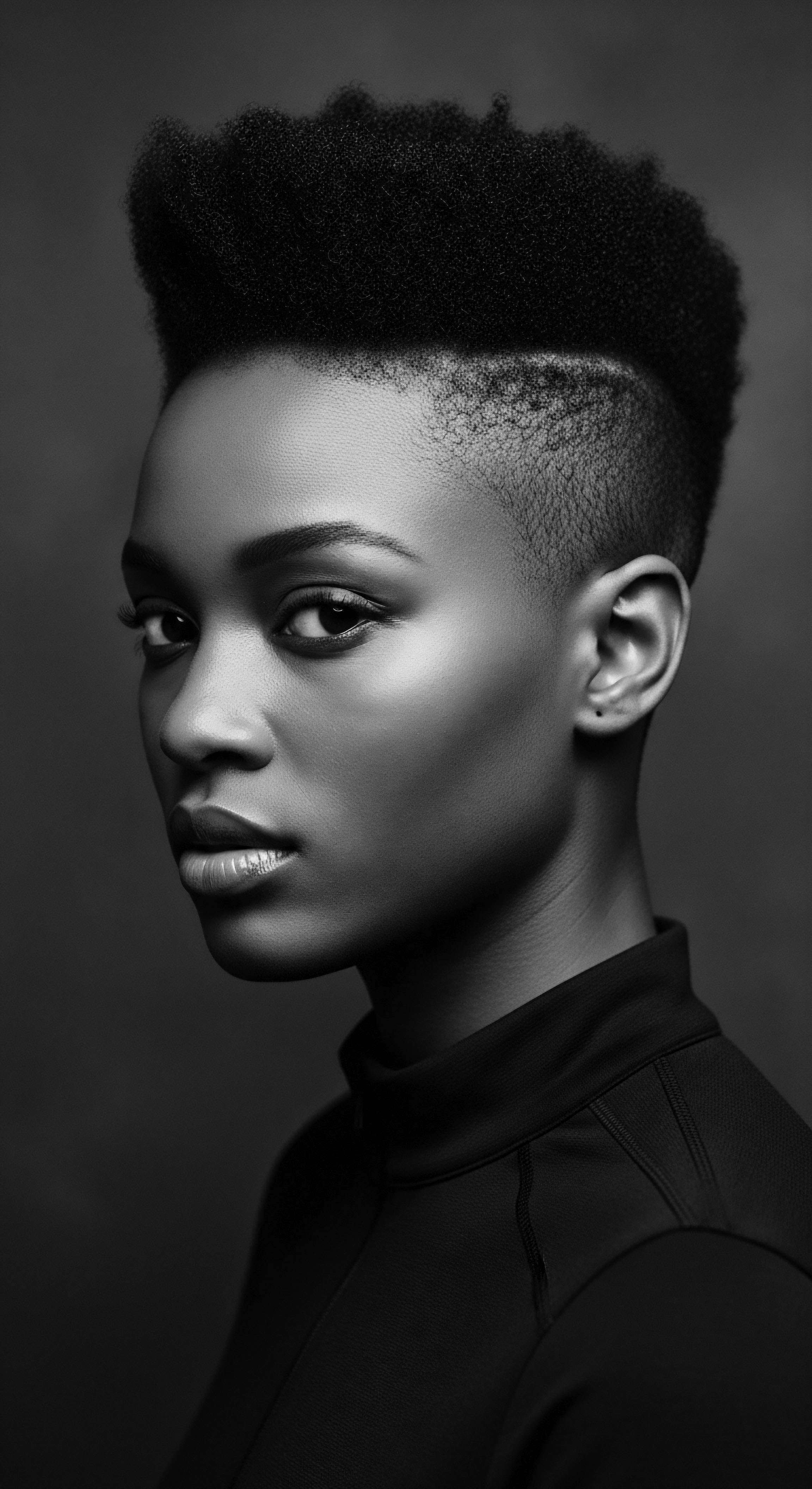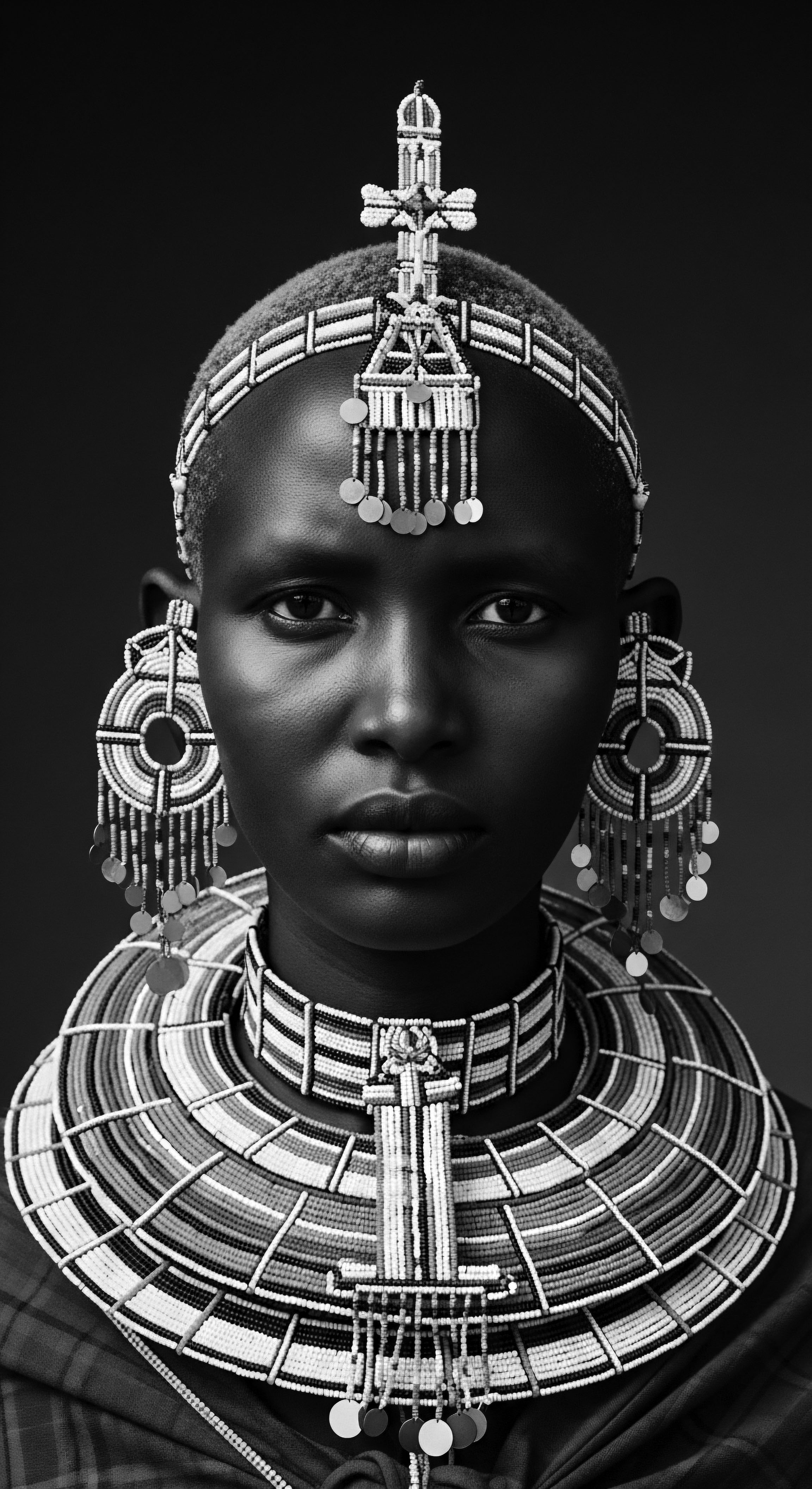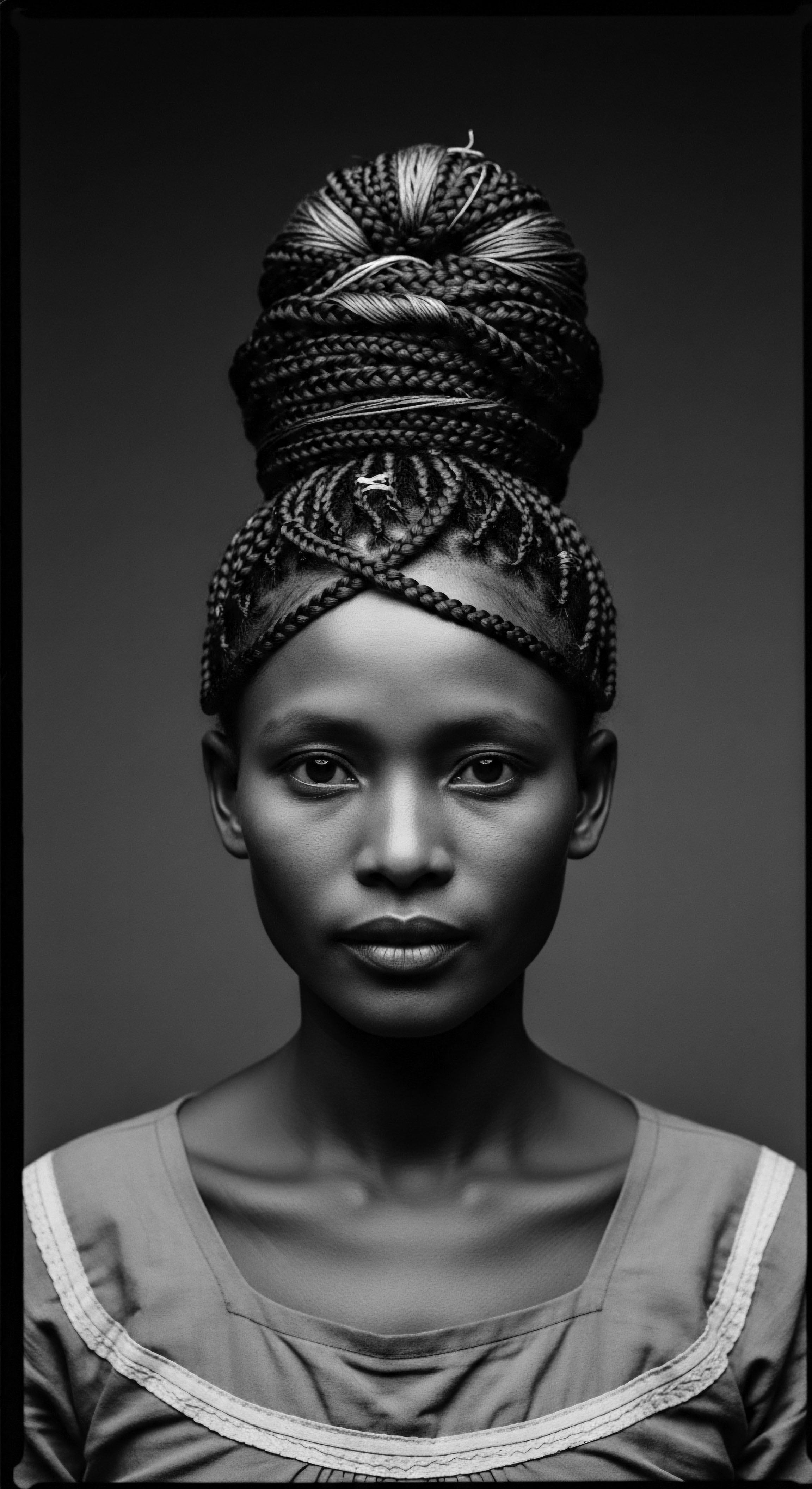
Roots
The whisper of silk against strands, the gentle embrace of a soft fabric around one’s crown — for many, this is a nightly ritual of care. Yet, for textured hair communities, especially those descending from the African diaspora, the bonnet holds a story far deeper than simple preservation. It is a chronicle steeped in survival, a testament to enduring spirit, and an emblem of defiance born from the crucible of oppression.
To truly grasp how a seemingly humble head covering transformed into a potent symbol of resistance, one must first walk back through time, listening to the echoes from ancient practices and understanding the intrinsic biology of hair that necessitated such care. This journey begins not with a choice, but with a profound necessity, interwoven with the heritage of Black and mixed-race peoples.

What Makes Textured Hair Distinctly Vulnerable and Resilient?
Textured hair, with its unique helical structure, presents a paradox of fragility and strength. The curls, coils, and kinks that define it, while possessing remarkable aesthetic range, also create points where the hair shaft naturally twists and bends. These points, known as torsion points, can become areas of weakness, making textured hair more prone to dryness and breakage than straighter hair types. The very architecture of the hair, with its raised cuticles, allows moisture to escape more readily, demanding constant hydration and gentle handling.
This inherent need for protection, understood ancestrally through observation and practice, laid the groundwork for head coverings. Early African communities recognized the sun’s drying power, the wind’s tangling effects, and the abrasive nature of daily life on delicate strands. Protective styles and coverings were not just adornment; they were crucial for maintaining hair health and integrity across generations.

Early Head Coverings in Ancestral Practices
Before the forced transatlantic removals, various African cultures adorned and protected their hair with elaborate headwraps and coverings. These were often symbols of social standing, marital status, spiritual connection, or tribal affiliation. The materials used ranged from natural fibers like cotton and linen to richly dyed fabrics. These coverings served a dual purpose ❉ practical protection from environmental elements and a visual language communicating identity and community.
The meticulous artistry involved in tying and styling these headwraps spoke volumes without uttering a word. They safeguarded delicate styles and preserved moisture in diverse climates, from the arid desert to humid tropics. This deep, functional wisdom about head coverings travelled across oceans, carried in the memories and practices of those forcibly displaced.
The intrinsic helical structure of textured hair necessitates protection, a wisdom understood and practiced across ancestral communities for generations.
The legacy of these protective practices is clear. African communities used these coverings not just for hair preservation, but also as expressions of their spiritual world and social hierarchies. Hair itself held deep meaning, connecting individuals to their lineage and cosmos. The decision to cover or adorn one’s hair was therefore steeped in cultural and personal significance, a practice that would be challenged but never truly extinguished by the trials to come.

Ritual
The passage through the Middle Passage and the institution of slavery sought to strip those enslaved of every vestige of their former lives, including their cultural practices and personal dignity. Hair, a profound marker of identity and heritage in African societies, became a target. Enslaved individuals often had their hair forcibly shorn upon arrival, a dehumanizing act designed to sever ties to their homeland and communal memory. Yet, even within this crucible of cruelty, the wisdom of protecting textured hair endured, transforming simple head coverings into essential elements of daily ritual and, ultimately, powerful statements of quiet defiance.

How Did Enslavement Alter the Role of Head Coverings?
During the era of forced labor, head coverings became a grim necessity. They protected hair from the sun, dirt, and harsh conditions of field work. Often, these head coverings were mere scraps of cloth, rags, or handkerchiefs—whatever could be found to shield hair from damage and maintain some semblance of neatness in the face of brutal circumstances. White enslavers often imposed these coverings, particularly on women, intending them as badges of servitude and to visually mark Black women as inferior or subhuman.
Laws were even enacted in certain areas to mandate that Black women cover their hair in public spaces. This imposition, however, inadvertently provided a new canvas for resistance.
The experience of enslaved women illuminates this transformation. For instance, in accounts from the 1800s, some African women were compelled to keep their hair covered in headwraps every day, with the exception of Sundays, when a few might remove their wraps to style their hair for church. This glimpse into their limited autonomy reveals a moment of reclaiming identity, however brief.
Without access to traditional combs or brushes, they would at times resort to wool carding tools to manage tangles, and use household items like butter or baking grease for moisture. These improvised acts of care, however small, represented a deep-seated commitment to personal upkeep and ancestral traditions amidst dehumanization.
| Historical Context Pre-Slavery Africa |
| Primary Function Protection from elements, aesthetic adornment |
| Symbolic Shift Cultural identity, social status, spiritual connection |
| Historical Context Era of Enslavement |
| Primary Function Protection during labor, imposed dehumanization |
| Symbolic Shift Self-preservation, covert communication, quiet dignity |
| Historical Context Post-Emancipation (Early) |
| Primary Function Hair preservation, adherence to societal norms |
| Symbolic Shift Assertion of identity, reclaiming beauty, challenging stigma |
| Historical Context The journey of head coverings reflects continuous adaptation and resistance within textured hair heritage. |

How Did Tignon Laws Spark Creative Acts of Defiance?
One of the most striking historical examples of this transformation unfolds in 18th-century Louisiana, with the enactment of the Tignon Laws in 1786. Spanish colonial Governor Esteban Miró, aiming to enforce a strict racial hierarchy and control the perceived “extravagance” of free women of color in New Orleans, mandated that all Black women, both free and enslaved, wear a head covering, or “tignon,” in public. The law’s intent was to visually mark them as belonging to a subordinate class, particularly to deter white men who were drawn to their elaborate hairstyles and refined appearance.
The community’s response was a profound act of resistance. Instead of allowing the tignon to become a sign of their subjugation, Black women, especially Creole women of color, transformed it into a vibrant expression of personal style and cultural pride. They used luxurious fabrics, often in bright colors, and developed elaborate, architectural wrapping techniques, adorning their headwraps with jewels, feathers, and ribbons. What was intended as a means of suppression became a powerful statement, radiating beauty and defiance.
This act of reappropriation demonstrated an unbroken spirit and a deeply ingrained connection to their ancestral heritage, where head adornment signified status and self-expression. Even after the Tignon Laws were no longer actively enforced, following the Louisiana Purchase in 1803, many Black women continued to wear headwraps, having reclaimed them as symbols of their dignity and cultural legacy.
The Tignon Laws, designed to suppress the vibrant self-expression of Black women, instead ignited a powerful counter-narrative of defiant beauty.
This historical episode underscores the resilience woven into the very fabric of textured hair heritage. The bonnet, or headwrap, evolved from a tool of imposed control into a chosen mode of self-expression.

Relay
The bonnet, in its contemporary manifestation, represents a relay of ancestral wisdom, bridging past necessity with present-day holistic care. Its journey from a mandated marker of subjugation to a celebrated accessory for textured hair stands as a testament to cultural survival and collective ingenuity. This enduring accessory performs a role beyond simple hair maintenance; it quietly supports the physical health of hair while serving as a daily affirmation of identity, linking modern practices to the profound heritage of Black and mixed-race communities.

What are the Foundational Principles of Nighttime Hair Preservation?
The core principle behind bonnets in hair care rests on their ability to minimize friction and retain moisture. Textured hair, by its very nature, is vulnerable to environmental stressors and mechanical damage. Sleeping on absorbent fabrics, such as cotton pillowcases, can strip hair of its natural oils and moisture, leading to dryness, frizz, and breakage.
The smooth surfaces of silk or satin bonnets allow hair to glide freely, reducing tangles and preserving the integrity of individual strands and existing styles. This practical application of material science, though perhaps not formally articulated in ancient terms, mirrors the protective instincts passed down through generations.
Modern scientific understanding validates these long-standing practices. The outermost layer of the hair shaft, the cuticle, acts as a protective shield. When hair is dry or subjected to friction, the cuticles can lift, leading to a rough surface that snags easily and loses moisture. Bonnets, by providing a smooth, enclosed environment, help keep the cuticles flat, thereby sealing in hydration and minimizing mechanical stress.
This physical protection supports the hair’s natural barrier, akin to a gentle nightly cocoon. The adoption of bonnets in modern routines therefore harmonizes scientific understanding with a deeply rooted ancestral wisdom concerning preservation and holistic well-being.

How do Bonnets Symbolize Contemporary Acts of Self-Affirmation?
Beyond their functional benefits, bonnets carry a weight of cultural meaning, particularly within Black communities. For many, wearing a bonnet is as routine as any other self-care ritual. It is a deliberate, conscious choice for self-preservation and an act of reclaiming what was once used to diminish.
This everyday practice quietly pushes against Eurocentric beauty standards that historically devalued textured hair and often promoted styles requiring harsh chemical treatments or excessive heat. By protecting and nurturing natural hair, the bonnet becomes a symbol of self-acceptance and a rejection of imposed beauty norms.
- Cultural Continuity ❉ The bonnet represents a direct link to ancestral practices of head covering, maintaining a continuous chain of knowledge across centuries.
- Hair Health Sovereignty ❉ Choosing to wear a bonnet asserts autonomy over one’s hair health, protecting it from damage and prolonging styles, reducing the need for constant manipulation.
- Community Affirmation ❉ The visibility of bonnets in public spaces, worn with pride, challenges historical stigma and affirms a shared cultural experience.
- Economic Empowerment ❉ The growth of Black-owned businesses creating and distributing bonnets contributes to economic self-sufficiency within the community, circulating resources and celebrating Black artistry.
The act of wearing a bonnet openly, whether at home or in certain public contexts, signals a quiet but resolute statement ❉ textured hair is valued, it is beautiful, and it deserves care. This contemporary usage is a direct inheritance from those who, centuries ago, turned forced coverings into a defiant art form. The modern bonnet user, perhaps unknowingly, carries forward the spirit of the Tignon women, transforming a simple accessory into a visible marker of cultural pride and an unspoken declaration of self-worth.
The bonnet serves as a living archive, transmitting ancestral care wisdom and affirming identity in a world still learning to honor Black hair.

Reflection
To hold a bonnet is to hold a fragment of history, a soft artifact of resilience. Its journey from a practical necessity born of environmental demands and later, a badge of imposed subservience, to its contemporary status as a personal guardian of strands and a bold proclamation of heritage, mirrors the very trajectory of textured hair itself. The bonnet is more than a tool; it is a whisper from generations past, a gentle hand guiding us toward mindful care, and a vibrant banner unfurled in celebration of identity.
In every silken fold, there resides the enduring spirit of ancestors who, through ingenuity and unyielding spirit, transformed oppressive mandates into expressions of their inner sovereignty. This everyday accessory, so intimately connected to the nighttime rituals of care, embodies the ‘Soul of a Strand’ ethos. It reminds us that care for textured hair extends beyond the tangible, touching upon emotional well-being, cultural connection, and historical remembrance.
The bonnet stands as a quiet yet powerful monument to a lineage that refused to be diminished, consistently finding ways to protect, adorn, and celebrate the magnificent helixes that crown them. It is a living, breathing archive of defiance, beauty, and unwavering self-love.

References
- Byrdie. (2022, September 27). The Significance and History of Bonnets.
- Hype Hair. (2023, June 26). Unveiling the History of the Hair Bonnet for Black Women.
- Helix Hair Labs. (2023, March 3). The History of the Hair Bonnet.
- NOIR ‘N NOLA. (2019, March 25). The Tignon Law ❉ How Black Women Formed Decor Out of Oppression.
- PBS. (n.d.). Slave Women and the Head-Wrap. Slavery and the Making of America.
- Refinery29. (2021, February 23). The Evolution Of The Natural Hair Movement.
- reframe52. (2024, February 8). Tignon Laws & Black Women’s Creative Resistance.
- Safo Hair. (2024, February 15). The Evolution of Black Hair Products ❉ A Journey from Homemade Remedies.
- Team True Beauty. (2023, December 7). The Significance and History of Black People Bonnets.
- VICE. (2018, April 10). When Black Women Were Required By Law to Cover Their Hair.
- Haenley Studio. (2020, September 15). Headwraps in the workplace?
- The Natural Hair Advocate. (2016, May 31). Wrap it Up ❉ A Tribute to the Head Tie.
- Art, Design, and Visual Thinking. (n.d.). The African American Woman’s Headwrap ❉ Unwinding the Symbols.
- Style on Main. (2025, April 14). How the Silk Bonnet Became a Symbol of Black Beauty.
- B.O.M.M. (2023, May 30). Bonnets ❉ A Cultural Staple in Black Communities.
